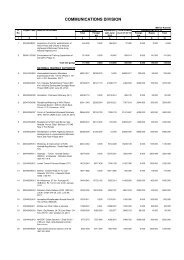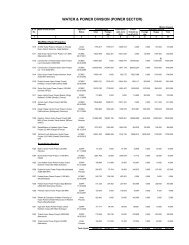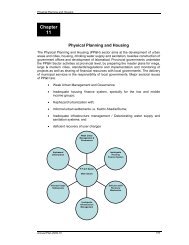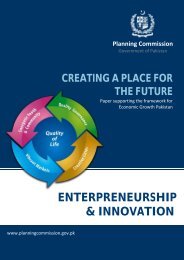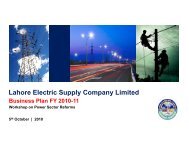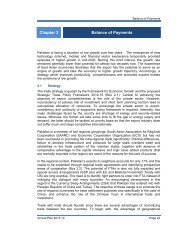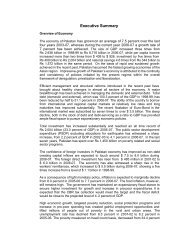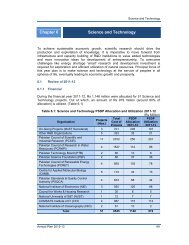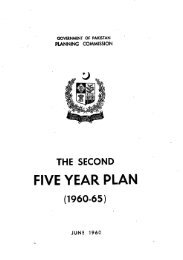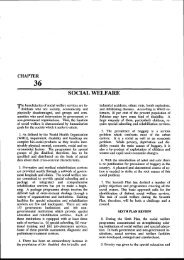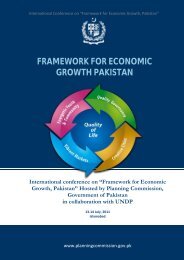Manual for Development Projects - Planning Commission
Manual for Development Projects - Planning Commission
Manual for Development Projects - Planning Commission
You also want an ePaper? Increase the reach of your titles
YUMPU automatically turns print PDFs into web optimized ePapers that Google loves.
Chapter 2<br />
New Ideas/Areas of Investment<br />
2.12 <strong>Planning</strong> is a continuous process which generates new ideas <strong>for</strong> and areas of profitable<br />
investment, as a result of the sense of dedication and past experience. It calls <strong>for</strong> selfless ef<strong>for</strong>ts in<br />
the national interest on the part of all sponsoring agencies in various sectors to go beyond the<br />
routine and explore new avenues of development and consequent growth of economy, to exploit/<br />
augment natural resources so as to eliminate dependence on external aid and usher in an era of selfrespect<br />
and prosperity <strong>for</strong> the people.<br />
2.13 More often than not, exploration and research are rewarded with rich returns. A case in point<br />
is OIL & GAS DEVELOPMENT, a national asset, harnessed by man's labour and skill <strong>for</strong> the<br />
benefit of the state. Investment in such enterprises of exploiting rare natural resources is immensely<br />
justified and the projects aimed at their exploration, extraction, transmission and refinement are<br />
readily identified as new areas of development/investment. These projects have self-evident<br />
potential and are self-identified. With adequate incentives from the Government, the bulk of the risk<br />
capital <strong>for</strong> oil/gas and hard minerals exploration should come from the private sector.<br />
2.14 In the sphere of new ideas and areas of investment, projects are identified by objectives not<br />
pursued properly owing to paucity of funds or lack of clear vision. Recently a campaign at<br />
government level has been started <strong>for</strong> the development of the arid zones of Sindh Province. The<br />
desert dwellers of the arid zones of Thar and Kohistan (like 'Thal' of Punjab) are endowed with the<br />
most unfriendly climate and totally hostile topography. They face frequent famines and are always<br />
hungry or half-fed, leading a life of unending misery. Their main problem is water and without<br />
water there is no life. The projects pertaining to this part are identified in their new areas of<br />
investment, namely, exploration, treatment, conveyance and distribution of water, particularly <strong>for</strong><br />
domestic use and livestock, alongside of the provision of basic health services and catering to the<br />
need <strong>for</strong> education, starting with the elementary level. These projects are prepared and executed by<br />
Sind Arid Zone <strong>Development</strong> Authority (SAZDA), a new organization created to work under the<br />
chairmanship of the Chief Minister, Sind. These projects and other similar ones aimed at<br />
ameliorating the sub-human living conditions of a part of the population are identified as based on<br />
new areas of investment.<br />
Potential <strong>Projects</strong><br />
Page 4 of 4<br />
2.15 As a matter of fact, all projects that bear the strain of scrutiny by the <strong>Planning</strong> <strong>Commission</strong>,<br />
and finally succeed to find a place in the approved development plans are beyond doubt potentially<br />
promising projects. In a narrower sense, however, projects could be distinguished and identified <strong>for</strong><br />
their potential of development in a particular sector of national economy. Fundamentally the<br />
projects are identified by the purpose they intend to accomplish in terms of time and money. Among<br />
other features, the single most attractive aspect of a project is more profitable benefit-cost ratio.<br />
However, there are projects which aim at the specific object of harnessing/enhancing the natural<br />
resources of the country to increase its capacity <strong>for</strong> longer-term gains. These are potentially<br />
productive projects. They pave the way by their large benefits to undertake ambitious development<br />
programmes <strong>for</strong> attainment of healthier and higher standards of living and <strong>for</strong> achievement of<br />
tangible targets in advancement of modern technologies.<br />
2.16 <strong>Projects</strong> promising reduction in unemployment, amelioration of educational standards,<br />
superior health services, and security of life and property, are identified as potential projects<br />
answering the aims of any state administration <strong>for</strong> the welfare and well-being of her people.<br />
http://hd2/pc/popup/ch2_p.html<br />
9/23/2010




